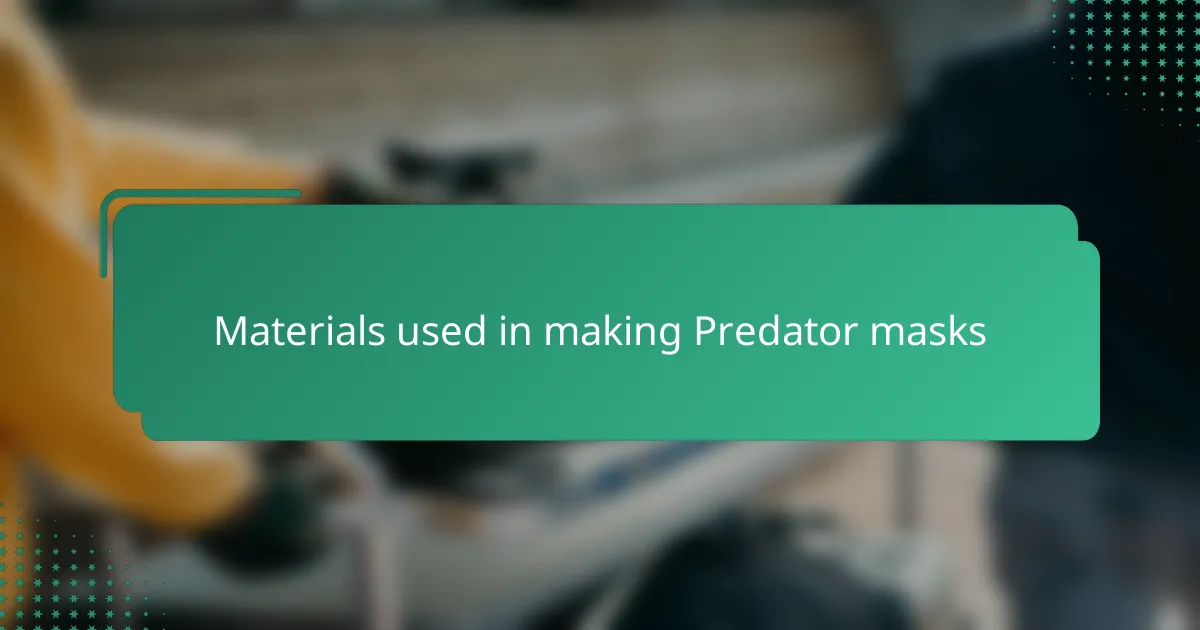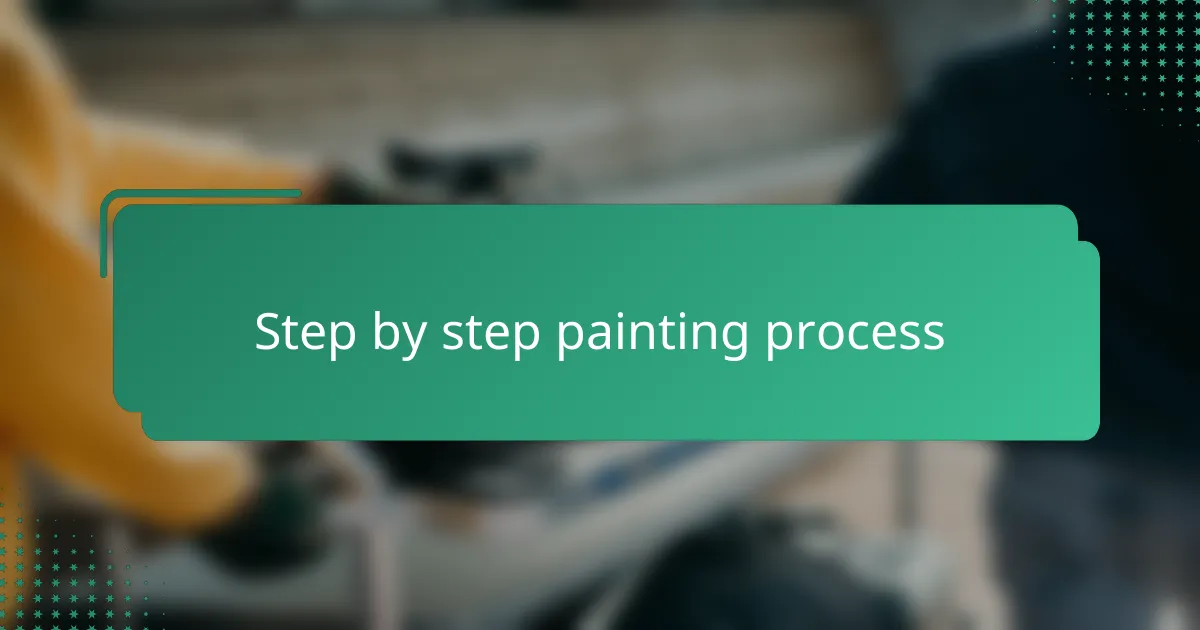Key takeaways
- Science fiction props, like Predator masks, blend art and technology, sparking imagination through detail and craftsmanship.
- Quality materials such as polyurethane resin, latex, and silicone are essential for creating authentic-looking masks with realism in texture and color.
- Patience and proper tools, including high-quality brushes and airbrush setups, are crucial in achieving detailed and cohesive paint jobs.
- Lighting and test spots greatly influence color perception and can prevent mistakes, enhancing the overall painting experience.

Understanding science fiction props
Science fiction props are not just ordinary objects; they are gateways into imaginary worlds. When I first encountered a Predator mask, I realized how much detail and creativity go into making something believable yet otherworldly. Have you ever wondered what makes a prop feel authentic, even when it’s clearly from another universe?
In my experience, understanding these props is about appreciating the blend of art and technology. Each piece tells a story, often crafted with careful attention to anatomy, texture, and function. It’s fascinating how these elements come together to spark our imagination and make the fictional real.
Sometimes, I find myself lost in thought about the craftsmanship behind these items—how every scratch, paint layer, or weathered effect adds depth and character. Isn’t it amazing how a simple mask can evoke such strong emotions and curiosity? That’s the magic of science fiction props—they invite us to explore beyond our everyday reality.

Materials used in making Predator masks
When I started painting my Predator mask, I was surprised by the variety of materials involved. The base was usually made from sturdy yet lightweight polyurethane resin, which felt solid in my hands but wasn’t too heavy to wear. Have you ever held something that feels both durable and flexible? That balance is crucial for masks that need to look authentic without being uncomfortable.
What fascinated me most was the use of latex and silicone for the finer details, like wrinkles and textures on the skin. These materials allowed the artists to capture the alien-like features that define the Predator’s intimidating look. I remember gently brushing paint over these surfaces, appreciating how the flexible material reacted, making the mask almost feel alive.
Finally, the paint itself was a story—special acrylics and airbrush paints designed to bond with resin and silicone without cracking or peeling. Layering different shades was a bit like sculpting with color, bringing out depth and realism. Have you ever tried to mimic the mottled patterns of an otherworldly creature? It’s challenging but incredibly rewarding when you see the mask transform under your brush.

Essential tools for painting masks
Painting a Predator mask demands the right tools to bring out those alien details convincingly. I found that high-quality brushes in various sizes were essential—tiny fine-tipped ones for intricate lines around the eyes and mouth, and broader ones for applying base coats. Using cheap brushes just made me frustrated as they shed bristles and ruined the smoothness I was aiming for.
Airbrushing was a game-changer for me. Having an airbrush setup allowed me to create subtle gradients and the iconic mottled patterns that define the Predator’s skin. It took some practice to control the pressure and flow, but once I got the hang of it, the results felt so much closer to the professional props I admire. Do you remember fumbling with tools that initially seemed overcomplicated? That was me, but it was worth every moment.
Beyond brushes and airbrushes, picking the right palette was another crucial step. I leaned heavily on acrylic paints formulated for resin and silicone—they adhered beautifully without cracking after drying. I realized that investing in proper painter’s tape and mixing palettes saved me from countless accidental smudges and color mishaps. Trust me, these small tools quietly make a huge difference when you’re deep in the painting process.

Step by step painting process
The first step I took was applying a solid base coat to the entire mask. It set the stage for everything else, like priming a canvas before painting a masterpiece. I remember feeling both excited and nervous as I brushed on that initial layer, wondering if I’d get the color just right to match the Predator’s eerie skin tone.
Next came the layering of various shades to mimic the mask’s unique texture and depth. I used my airbrush here, carefully spraying darker greens and muted browns in mottled patterns. It was almost meditative, watching the colors blend seamlessly while imagining the alien origins of this fearsome creature.
Finally, adding the finer details made all the difference—tiny highlights around the mask’s ridges, subtle weathering to simulate wear, and the signature yellow eyes that seemed to stare right back at me. At times, I questioned if my work was detailed enough, but stepping back, I realized those small touches were what truly brought the mask to life. Have you ever had a moment when a project suddenly feels real? That’s exactly what happened with mine.

Common challenges and solutions
One challenge I faced was ensuring the paint adhered well to the different materials like resin and silicone. Have you ever tried painting on a surface where the paint just won’t stick? That frustration pushed me to research primers and compatible paints, which made a huge difference in preventing peeling and cracking over time.
Another hurdle was capturing the complex mottled pattern characteristic of the Predator’s skin. At first, my airbrushing attempts looked blotchy and unnatural. After some trial and error, I learned to build up thin layers gradually, letting each dry before adding the next. This patient layering created the depth I was after and really brought the mask to life.
Lastly, dealing with tiny details around the eyes and [censured] ridges tested my steady hand and focus. There were moments when a smudge felt like ruining hours of work, but I discovered that having the right fine brushes and going slow was essential. It taught me that perfection in painting props comes from persistence and embracing small imperfections as part of the piece’s character.

Personal tips and techniques
When I started painting, I quickly realized that patience is my best friend. Did I rush through layers only to see them smudge or blend wrong? Absolutely. Taking my time between coats made all the difference—letting each layer dry fully helped the colors build up naturally without muddying the intricate patterns. It’s a small habit, but it saved me so many headaches.
I also learned how crucial lighting is while working on the mask. There were times I thought a color looked perfect under soft room light, only to see it look totally different in daylight. Setting up a bright, neutral light source helped me judge tones more accurately. Have you ever been surprised by how your paint looks under different lighting? It’s something I now always consider before declaring a layer finished.
Finally, don’t overlook the power of test spots. Early on, I would dive right into painting the main areas and regret it later when certain colors didn’t behave as expected on the silicone or resin. By trying out small patches first, I discovered how different paints reacted, which saved me from major fixes later. It taught me that a little planning really pays off in complex projects like this.


